Chapter 4
Biological Objectives of Retreatment
Aim
To review the biological objectives of retreatment and how they may be attained to transform failure into successful healing.
Outcome
At the end of this chapter, the practitioner should have a clear understanding of what they are trying to achieve when they retreat a failed endodontic case, and be conversant with the treatment measures necessary to gain success.
Introduction
The primary aim of root canal treatment is the elimination and future exclusion of infection from the root canal system (Fig 4-1). Endodontic failures usually result from failure to achieve this primary aim and retreatment is intended to correct the inadequacies of initial treatment.
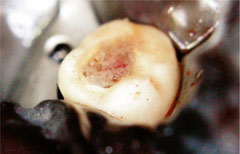
Fig 4-1 The primary aim of root canal treatment is the elimination and future exclusion of infection of the root canal system.
The Microbial Flora
The microbial flora of infected root canals is complex. Depending on whether it is a primary or secondary infection, it may consist of cocci, rods (Fig 4-2), spirochaetes, filaments and fungi, often maintaining each other in ecological and nutritional relationships. They may exist in two forms:
-
planktonic – loose collections or suspensions of microorganisms within the root canal lumen
-
biofilm – dense aggregates, forming plaques on and within the root canal dentine wall.
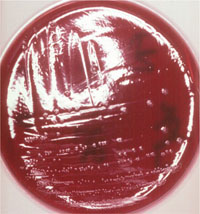
Fig 4-2 Blood agar culture of Fusobacterium nucleatum, a rod-shaped endodontic pathogen.
Microbes may also invade the tubular structure of the dentine walls (Fig 4-3) to depths of 300 µm or more.
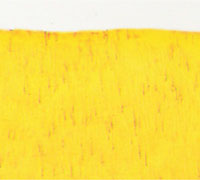
Fig 4-3 Dentinal tubules invaded by bacteria, labelled with special stain.
Elimination of Microorganisms
Elimination of microorganisms from the root canal system is normally accomplished by:
-
mechanical instrumentation
-
chemical antimicrobial agents, including irrigants and medicaments.
Exclusion of New Microbial Infection
Microorganisms can be prevented from entering the cleaned root canal system by ensuring a “total canal seal” by placing a:
-
complete root canal filling (apical seal) and
-
coronal restoration (coronal seal).
All elements of the process are important in ensuring success.
apical seal + coronal seal = total canal seal
Fulfilling the Biological Objectives
It is not the intention of this chapter to revise basic endodontic skills; these are covered in the first book of the series, Rational Root Canal Treatment in Practice. However, to fulfil the biological objectives of retreatment, a number of practical considerations and recommendations are reinforced.
Aseptic Treatment Regime
Tooth isolation using rubber dam (Fig 4-4) should be considered as mandatory for all endodontic procedures, in accordance with the principles of controlled asepsis. To guard against unplanned fracture, teeth with severe coronal tissue loss, heavy occlusion contacts or with cracks must be relieved from significant occlusal loading and protected, even in the short-term, by placing an orthodontic band (Fig 4-5) or temporary crown. The temporary restoration should additionally prevent recontamination of the root canal system by precluding the ingress of oral fluids and microorganisms.
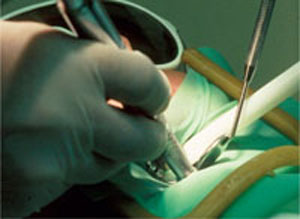
Fig 4-4 Rubber dam is mandatory for all endodontic procedures.
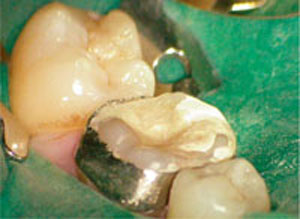
Fig 4-5 Orthodontic band placed to protect a structurally fragile tooth.
Access
A tooth cannot be retreated until the canal system is re-entered.
Coronal access
The first obstacle to overcome is to enter the pulp chamber and uncover the root canal filling. This entails getting past the coronal restoration and any underlying core material, including posts.
Radicular access
The next obstacle is whatever may be obstructing instrumentation of the whole canal system including the root filling material. The task is to clear the root canal system so that it is negotiable to its terminus, to enable recleaning, reshaping and refilling so as to achieve and preserve periapical health. The retreatment techniques to gain coronal and radicular access will be covered in Chapters 5 and 6, respectively.
Mechanical Instrumentation
In primary treatment, the goals of mechanical preparation are to:
-
thoroughly clean
-
adequately shape the canal system.
In retreatment, previous efforts may have resulted in:
-
underpreparation
-
overpreparation
-
a combination of both, in different parts of the root canal system.
Whether the root canal system is underprepared or overprepared, it should be recleaned and redisinfected, to remove microorganisms and pulpal remnants.
If the canals are underprepared, they should be shaped to produce a smooth, continuously tapered preparation, widest coronally and narrowest at the apical terminus. The shape should allow effective penetration of the root canal irrigant and placement of a good-quality root filling.
If the root canals are overprepared, they should be reshaped so that a retentive form is reestablished to contain the root filling. Heavy planning of fragile canals walls is often unnecessary for effective cleaning; wherever possible, valuable tooth tissue should always be conserved.
Accurate determination of working length is as important in retreatment as in primary treatment to:
-
correct the previous deficiencies of cleaning and shaping
-
avoid injuring the periapical tissues
-
prevent further, or correct existing, procedural errors
-
confine the root filling within the root canal system.
The apical limit for root canal procedures is generally accepted to be the apical constriction. In cases where there is chronic infection, inflammatory apical root resorption (Fig 4-6) may have destroyed the natural contours of the periapex, making it difficult to determine accurately the canal length. An electronic apex locator is helpful in these cases, but the canal length should be verified by taking the necessary radiographs. New generations of gradient impedance apex locators (e.g. Root ZX, Morita, Kyoto, Japan) (Fig 4-7) which employ two or more frequencies are more reliable and less susceptible to in/>
Stay updated, free dental videos. Join our Telegram channel

VIDEdental - Online dental courses


